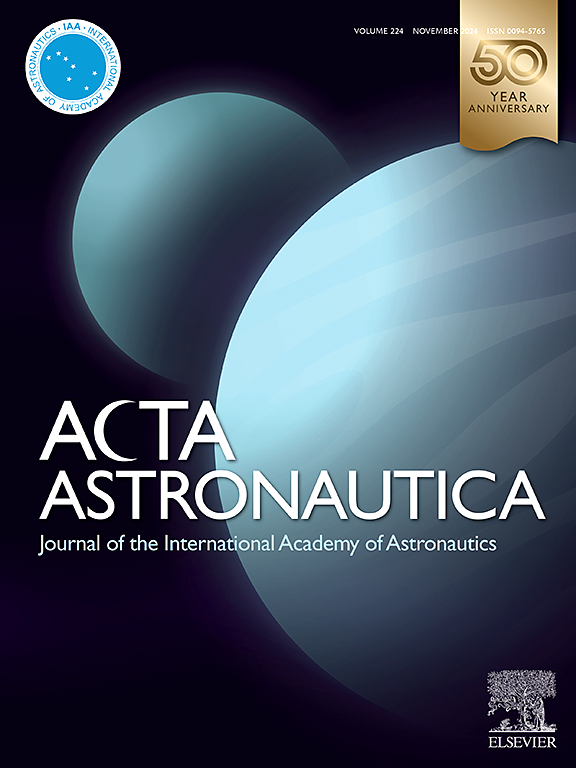近真空中超音速射流撞击诱导的弹坑形成和粒子抛射
IF 3.1
2区 物理与天体物理
Q1 ENGINEERING, AEROSPACE
引用次数: 0
摘要
本研究研究了近真空条件下超音速射流撞击陨石坑的形成和演化,重点研究了风化层颗粒抛射动力学。实验在格拉斯哥大学的羽状风化层设施进行,在那里控制喷射脉冲(0.1,0.5和1.0 s)被引导到高密度和低密度的风化层模拟物。利用粒子图像测速(PIV)和红外成像技术,对多个连续喷射脉冲下的陨石坑形态和喷出物分布进行了分析。结果表明,高密度风化层形成致密、壁陡的u型陨石坑,而低密度风化层形成较大、倾斜的v型陨石坑。较长的脉冲持续时间导致火山口扩大和较高的弹射角度。特别是,陡峭的陨石坑会促进喷管轴附近的高角度喷射,对航天器着陆器构成潜在风险。无论风化层密度如何,抛射粒子的抛射角在40°到50°之间,表明在低重力环境下进行了长途旅行。这些发现提高了我们对羽层-风化层相互作用的理解,并通过告知数值模型和航天器设计考虑因素,有助于更安全的行星着陆策略。本文章由计算机程序翻译,如有差异,请以英文原文为准。
Crater formation and particle ejection induced by supersonic jet impingement in near-vacuum
This study investigates the formation and evolution of craters under near-vacuum conditions due to supersonic jet impingement, with a focus on regolith particle ejection dynamics. Experiments were conducted at the Plume-Regolith Facility of the University of Glasgow, where controlled jet pulses (0.1, 0.5 and 1.0 s) were directed to high- and low-density regolith simulants. Using Particle Image Velocimetry (PIV) and infrared imaging, the crater morphology and ejecta distribution were analysed over multiple sequential jet pulses. The results indicate that the high-density regolith forms compact, steep-walled U-shaped craters, while the low-density regolith produces larger, sloped V-shaped craters. Longer pulse durations result in increased crater expansion and higher ejection angles. In particular, steep-walled craters promote high-angle ejection near the nozzle axis, posing potential risks to spacecraft landers. Regardless of regolith density, expelled particles exhibit ejection angles between 40°and 50°, suggesting long-distance travel in low-gravity environments. These findings improve our understanding of plume-regolith interactions and contribute to safer planetary landing strategies by informing numerical models and spacecraft design considerations.
求助全文
通过发布文献求助,成功后即可免费获取论文全文。
去求助
来源期刊

Acta Astronautica
工程技术-工程:宇航
CiteScore
7.20
自引率
22.90%
发文量
599
审稿时长
53 days
期刊介绍:
Acta Astronautica is sponsored by the International Academy of Astronautics. Content is based on original contributions in all fields of basic, engineering, life and social space sciences and of space technology related to:
The peaceful scientific exploration of space,
Its exploitation for human welfare and progress,
Conception, design, development and operation of space-borne and Earth-based systems,
In addition to regular issues, the journal publishes selected proceedings of the annual International Astronautical Congress (IAC), transactions of the IAA and special issues on topics of current interest, such as microgravity, space station technology, geostationary orbits, and space economics. Other subject areas include satellite technology, space transportation and communications, space energy, power and propulsion, astrodynamics, extraterrestrial intelligence and Earth observations.
 求助内容:
求助内容: 应助结果提醒方式:
应助结果提醒方式:


